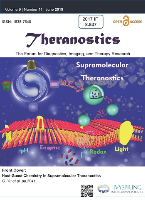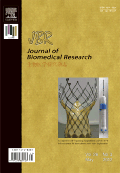
Biomedical Journal
Scope & Guideline
Pioneering Insights in Medicine
Introduction
Aims and Scopes
- Extracellular Vesicles and Cell Signaling:
The journal emphasizes studies on extracellular vesicles, exploring their roles in intercellular communication, immune response, and disease pathology. - Microbiome and Disease Interactions:
Research on the gut microbiome's influence on health and disease, particularly its interactions with therapies and immune responses, is a critical area of focus. - Cancer Biology and Therapeutics:
The journal publishes significant findings related to cancer biology, including molecular mechanisms, therapeutic strategies, and novel biomarkers for diagnosis and treatment. - Neurobiology and Mental Health:
Investigations into neurobiology, including the effects of stress and aging on mental health, neurodegenerative diseases, and cognitive functions, are prevalent. - Regenerative Medicine and Stem Cell Therapy:
A strong emphasis is placed on regenerative medicine, particularly the therapeutic applications of stem cells in treating various diseases and injuries. - Innovative Diagnostic Tools:
The journal highlights the development of novel diagnostic techniques, including biomarker identification and imaging technologies for early disease detection.
Trending and Emerging
- Immunotherapy and Cancer Treatment:
A growing number of studies are focusing on immunotherapeutic approaches for cancer treatment, highlighting the potential of harnessing the immune system to combat malignancies. - Microbiome Research in Health and Disease:
There is an increasing trend towards understanding the role of the microbiome in various diseases, including its impact on treatment responses and overall health. - Long Non-Coding RNAs in Disease Progression:
Research into long non-coding RNAs is on the rise, with studies demonstrating their regulatory roles in cancer and other diseases, paving the way for novel therapeutic targets. - Digital Health and Telemedicine:
The COVID-19 pandemic has accelerated research in digital health and telemedicine, focusing on remote patient monitoring, virtual consultations, and their effectiveness in healthcare delivery. - Artificial Intelligence in Healthcare:
The integration of artificial intelligence for diagnostic and predictive purposes is emerging, showcasing its potential to enhance clinical decision-making and patient outcomes.
Declining or Waning
- Traditional Pharmacological Approaches:
Research focused solely on conventional pharmacological treatments is declining as there is a growing interest in personalized medicine and alternative therapies. - Invasive Surgical Techniques:
There is a noticeable reduction in studies centered on invasive surgical methods, with a shift towards less invasive and more patient-centered approaches. - Basic Laboratory Studies Without Clinical Relevance:
Papers that do not connect basic laboratory findings to clinical applications or implications are becoming less common, as the journal seeks translational research.
Similar Journals

JOURNAL OF CELL BIOLOGY
Transforming Understanding Through Cellular ResearchJOURNAL OF CELL BIOLOGY, published by Rockefeller University Press, stands as a leading authority in the fields of Cell Biology and Medicine, reflected by its esteemed Q1 ranking in both categories as of 2023. Established in 1955, this journal has become a pivotal platform for disseminating groundbreaking research that enhances our understanding of cellular processes and their implications in various biological contexts. With a broad scope that encompasses experimental and theoretical studies alike, the JOURNAL OF CELL BIOLOGY embraces a rich diversity of topics, making it essential reading for researchers, students, and professionals committed to advancing cellular research. Although the journal does not currently offer open access options, its robust reputation, underscored by a competitive Scopus ranking of 43 out of 285 in the Cell Biology category, ensures that published findings reach a wide audience and influence the ongoing discourse in the life sciences. For those interested in staying at the forefront of cell biological research, the JOURNAL OF CELL BIOLOGY represents a critical resource.

Theranostics
Transforming Therapeutics through Collaborative Research.Theranostics is a premier journal in the field of Medicine and Pharmacology, published by IVYSPRING INT PUBL. With its commitment to open access since 2011, it facilitates the widespread dissemination of innovative research, fostering collaboration and advancements in therapeutic diagnostics. The journal proudly holds a Q1 ranking in both Medicine (Miscellaneous) and Pharmacology, Toxicology and Pharmaceutics, as of 2023, showcasing its esteemed position within the scientific community. Recognized globally, it ranks in the top 1%, with Scopus rankings placing it as 4th out of 398 in Medicine and 1st out of 43 in Pharmacology. Theranostics serves as a crucial platform for researchers, professionals, and students to explore cutting-edge developments as it converges multidisciplinary approaches to enhance patient care and treatment efficacy. With a focus on bridging experimental research and clinical applications, the journal is instrumental in shaping future therapies and diagnostic strategies.

Inflammation and Regeneration
Connecting researchers to the latest in inflammation and regeneration.Inflammation and Regeneration is a prominent open-access journal published by BMC, focused on the discerning fields of immunology, cell biology, and regenerative medicine. Since its establishment in 2016, the journal has provided a platform for the dissemination of high-quality research, contributing significantly to the advancement of knowledge in inflammation processes and regenerative therapies. With a remarkable impact reflected in its Q1 quartile rankings in Cell Biology and Immunology for 2023, Inflammation and Regeneration stands out as a leading resource for researchers and practitioners. The journal's commitment to open access ensures that critical findings are readily available to a global audience, fostering collaboration and innovation in the scientific community. With a Scopus ranking that places it in the top 20% of its categories, Inflammation and Regeneration serves as an essential reference for those seeking to stay at the forefront of immunological research and its applications.

Cell Discovery
Empowering Open Access to Cutting-Edge ResearchCell Discovery, published by SPRINGERNATURE, is a premier open access journal in the dynamic fields of Biochemistry, Cell Biology, Genetics, and Molecular Biology. Since its inception in 2015, this journal has established itself as a key platform for disseminating high-impact research and is recognized with a Q1 ranking across all its core categories for the year 2023. With its remarkable Scopus rankings—7th in Genetics, 9th in Biochemistry, 13th in Molecular Biology, and 15th in Cell Biology—Cell Discovery positions itself among the elite journals in life sciences, showcasing the most innovative breakthroughs and comprehensive reviews. Based in the United Kingdom, this journal operates under an open access model, ensuring that groundbreaking discoveries are readily available to researchers, professionals, and students around the globe. With a commitment to advancing scientific knowledge, Cell Discovery welcomes contributions that push the frontiers of our understanding in cellular and genetic sciences.

Journal of Biomedical Research
Elevating Biomedical Research Through Rigorous ScholarshipJournal of Biomedical Research, published by Nanjing Medical University in China, is a prominent platform for groundbreaking discoveries in the fields of Biochemistry, Genetics, and Molecular Biology, as well as Medicine. With an ISSN of 1674-8301 and an E-ISSN of 1876-4819, the journal offers a vital opportunity for researchers, professionals, and students to disseminate insightful research findings. Although not currently available as an open access journal, its inclusion in the second quartile of both Biochemistry and Medicine categories underscores its growing influence and commitment to high-quality scholarship, as evidenced by its historical compliance with Scopus rankings prior to 2009. By fostering an interdisciplinary approach, the Journal of Biomedical Research aims to bridge gaps in current biomedical understanding and encourages innovative research that can lead to significant contributions in improving health outcomes. Its editorial policies guarantee rigorous peer review, making it a trusted source of knowledge in the biomedical community.

Stem Cells International
Fostering Collaboration in Cutting-edge Stem Cell ResearchStem Cells International is a premier open access journal published by HINDAWI LTD, focusing on the rapidly evolving field of stem cell research. With an ISSN of 1687-966X and E-ISSN 1687-9678, this journal has been a vital resource since its inception in 2010, showcasing innovative studies and breakthroughs up to 2024. Positioned in Q3 in Cell Biology and Q2 in Molecular Biology for 2023, as well as well-ranked in the Scopus database, the journal serves as an essential platform for researchers, professionals, and students dedicated to exploring the implications of stem cell technology in regenerative medicine and biological research. The open access model ensures wide accessibility, fostering collaboration and knowledge-sharing across the scientific community, making it a cornerstone in advancing the understanding and application of stem cell science.

JOURNAL OF CELLULAR PHYSIOLOGY
Pioneering Insights into Cellular DynamicsJOURNAL OF CELLULAR PHYSIOLOGY, published by Wiley, is a leading peer-reviewed journal that has been at the forefront of cellular research since its inception in 1945. With its prestigious Q1 and Q2 rankings in the fields of Clinical Biochemistry and Cell Biology, this journal is highly regarded within the scientific community, reflecting its significant impact factor and rigorous peer-review process. Addressing the intricacies of cell function and physiology, it serves as a crucial resource for researchers, professionals, and students dedicated to advancing knowledge in the life sciences. The journal publishes cutting-edge research articles, integral reviews, and significant findings that bridge basic biology and clinical applications, ensuring access to high-quality scholarly content that informs current practices and future research directions. Although not open access, the journal maintains a rich archive of studies, making it an essential reference point for those invested in the health and biological sciences.

Genes & Diseases
Shedding light on the genetic foundations of disease.Genes & Diseases, published by KEAI PUBLISHING LTD, is a premier open-access journal dedicated to advancing the fields of genetics, biochemistry, and molecular biology. Established in 2014 and headquartered in Beijing, China, this journal has quickly risen to prominence, securing a place in the prestigious Q1 quartile in Biochemistry and Genetics (clinical), as well as Q2 in Cell Biology and Q1 in Molecular Biology as of 2023. With a commitment to disseminating cutting-edge research, Genes & Diseases serves as a critical platform for researchers, professionals, and students alike, ensuring that high-quality scientific work is openly accessible to the global community. The journal's exceptional impact is underscored by its selective Scopus rankings, which reflect its influence and relevance in key scientific domains, making it an essential resource for those exploring the intersections of genetics and disease pathology.

Journal of Stem Cells & Regenerative Medicine
Empowering Discoveries in Regenerative MedicineThe Journal of Stem Cells & Regenerative Medicine is a leading publication dedicated to the advancing field of stem cell research and regenerative medicine. Established in India and published by JOURNAL STEM CELLS & REGENERATIVE MEDICINE, this Open Access journal has been available since 2007, providing researchers and practitioners with free and unrestricted access to high-quality articles. With an ISSN of 0973-7154, the journal is indexed in Scopus, featuring a wide array of topics and insights into biochemistry, biotechnology, cell biology, and molecular biology, as denoted by its relevant quartile rankings. This journal is committed to bridging the gap between laboratory research and clinical applications, making significant contributions to the scientific community. The convergence of innovative studies from 2010 to 2024 positions it as an invaluable resource for those looking to stay at the forefront of stem cell and regenerative medicine research.

FASEB BioAdvances
Transforming Insights into Impactful ResearchFASEB BioAdvances, published by WILEY, is an esteemed open-access journal dedicated to advancing the fields of biochemistry, molecular biology, and physiology. Since its inception in 2019, the journal has rapidly established a significant presence within the academic community, boasting an impressive impact factor reflective of its Q2 and Q3 standings across various categories, including Biochemistry, Genetics and Molecular Biology, Cancer Research, Molecular Medicine, and Physiology. The journal aims to disseminate high-quality research and innovative findings to enhance the understanding of biological processes, making it a vital resource for researchers, professionals, and students alike. With its commitment to open access, FASEB BioAdvances ensures that groundbreaking research is available to a global audience, facilitating collaboration and exploration in these rapidly evolving scientific domains.